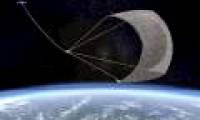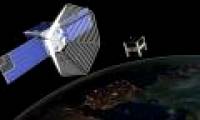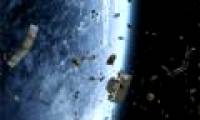
According to the Mirror, scientists estimate that there are about 600,000 pieces of space junk flying around the Earth.

On October 4, 1957, Sputnik I became the first satellite of humanity to fly into space. But this satellite also marks another milestone in history, which is the emergence of

According to The Guardian, Japan 's Earth - Orb garbage - removal test on February 6 ended in failure, a specially designed Japanese magnetic grid to remove space junk could not be

NASA estimates that more than 500,000 fragments are floating at speeds of up to 28,162 km / h (17,500 mph) around the Earth.

We have about 500,000 pieces of trash, ranging from 1cm to 10cm, and about 22,000 other pieces larger than 10cm are flying around Earth orbit.

The threat from cosmic garbage is increasing as more and more missile or satellite fragments fail or stop appearing in orbit near Earth.

The Japan Space Exploration Agency (JAXA) cooperates with a fishing equipment manufacturing company to create a kind of net from school, dedicated to clearing space.

Switzerland plans to launch a satellite

One of the first US satellites named Explorer 8 launched on October 3, 1960 after half a century of orbiting into the dense atmosphere on March 31.

According to the Associated Press, Swiss scientists plan to launch a specially designed
 According to the Mirror, scientists estimate that there are about 600,000 pieces of space junk flying around the Earth.
According to the Mirror, scientists estimate that there are about 600,000 pieces of space junk flying around the Earth. On October 4, 1957, Sputnik I became the first satellite of humanity to fly into space. But this satellite also marks another milestone in history, which is the emergence of
On October 4, 1957, Sputnik I became the first satellite of humanity to fly into space. But this satellite also marks another milestone in history, which is the emergence of According to The Guardian, Japan 's Earth - Orb garbage - removal test on February 6 ended in failure, a specially designed Japanese magnetic grid to remove space junk could not be
According to The Guardian, Japan 's Earth - Orb garbage - removal test on February 6 ended in failure, a specially designed Japanese magnetic grid to remove space junk could not be NASA estimates that more than 500,000 fragments are floating at speeds of up to 28,162 km / h (17,500 mph) around the Earth.
NASA estimates that more than 500,000 fragments are floating at speeds of up to 28,162 km / h (17,500 mph) around the Earth. We have about 500,000 pieces of trash, ranging from 1cm to 10cm, and about 22,000 other pieces larger than 10cm are flying around Earth orbit.
We have about 500,000 pieces of trash, ranging from 1cm to 10cm, and about 22,000 other pieces larger than 10cm are flying around Earth orbit. The threat from cosmic garbage is increasing as more and more missile or satellite fragments fail or stop appearing in orbit near Earth.
The threat from cosmic garbage is increasing as more and more missile or satellite fragments fail or stop appearing in orbit near Earth. The Japan Space Exploration Agency (JAXA) cooperates with a fishing equipment manufacturing company to create a kind of net from school, dedicated to clearing space.
The Japan Space Exploration Agency (JAXA) cooperates with a fishing equipment manufacturing company to create a kind of net from school, dedicated to clearing space. Switzerland plans to launch a satellite
Switzerland plans to launch a satellite One of the first US satellites named Explorer 8 launched on October 3, 1960 after half a century of orbiting into the dense atmosphere on March 31.
One of the first US satellites named Explorer 8 launched on October 3, 1960 after half a century of orbiting into the dense atmosphere on March 31. According to the Associated Press, Swiss scientists plan to launch a specially designed
According to the Associated Press, Swiss scientists plan to launch a specially designed




 NASA's 'Ninth Planet' Shows Signs of Being Friendly to Life
NASA's 'Ninth Planet' Shows Signs of Being Friendly to Life Why did American astronauts have to be quarantined when returning to Earth?
Why did American astronauts have to be quarantined when returning to Earth? China surprises the world by building a cable-stayed bridge 'above the clouds'
China surprises the world by building a cable-stayed bridge 'above the clouds' Why do women sleep less and wake up more than men?
Why do women sleep less and wake up more than men? Revealing the secret inside the stuffed animal claw machine, from there, summarizing experience to help you increase your winning rate many times over
Revealing the secret inside the stuffed animal claw machine, from there, summarizing experience to help you increase your winning rate many times over What would happen if you dug a hole through the Earth and jumped in?
What would happen if you dug a hole through the Earth and jumped in? Camera takes a photo that lasts 1,000 years
Camera takes a photo that lasts 1,000 years Was there nuclear war in ancient times?
Was there nuclear war in ancient times?